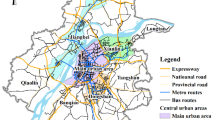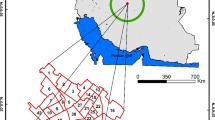Abstract
This paper calculated spatial accessibility of all counties (city, urban district) in China with cost weighted distance method. Region divisions of county accessibility were conducted, and relation of traffic accessibility and population aggregation was discussed in this paper. The results indicated that county accessibility in China had mainly low values and a distribution structure of circle layer and reverse-to-natural gradient. There was an obvious correlation between county accessibility and population density in China. With these analyses, inner mechanisms of population migration in different traffic conditions and region types were revealed, and can provide useful proposals to regional planning, traffic planning and smart distribution of people in China.
Similar content being viewed by others
References
Billie G C et al., 2005. Increasing walking: How important is distance to, attractiveness, and size of public open space? American Journal of Preventive Medicine, 28(2S2): 169–172.
Brown Coff A A, 1959. Zhang Ruliang trans. Urban Transportation and Street Planning. Beijing: Architecture Engineering Press.
Cao Xiaoshu, Xue Desheng, Yan Xiaopei, 2005. A study on the urban accessibility of national trunk highway system in China. Acta Geographica Sinica, 60(6): 903–910. (in Chinese)
Cao Xiaoshu, Yan Xiaopei, 2003. The impact of the evolution of land network on spatial structure of accessibility in the developed areas: The case of Dongguan city in Guangdong province. Geographical Research, 3(22): 305–312. (in Chinese)
Chen Jie, Lu Feng, Cheng Changxiu, 2007. Advance in accessibility evaluation approaches and applications. Progress in Geography, 26(5): 100–110. (in Chinese)
Deichmann U, 1997. Accessibility indicators in GIS. Department for Economic and Social Information and Policy Analysis, United Nations Statistics Division, 24.
Goodall B, 1987. Dictionary of Human Geography. London: Penguin.
Gutierrez J, Gonzalez R, Gomez G, 1996. The European high speed train network: Predicted effects on accessibility patterns. Journal of Transport Grography, 4(4): 227–238.
Hansen W G, 1959. How accessibility shapes land-use. Journal of the American Institute of Planners, 25: 73–76.
Jin Fengjun, Wang Jiao’e, 2004. Railway network expansion and spatial accessibility analysis in China: 1906–2000. Acta Geographica Sinica, 59(2): 293–302. (in Chinese)
Kwan M P, Murray A T, 2003. Recent advances in accessibility research: Representation, methodology and applications. Geographical Systems, 5: 129–138.
Li Pinghua, Lu Yuqi, 2005. Review and prospectation of accessibility research. Progress in Geography, 24(3): 69–78. (in Chinese)
Lu Yuqi, 2002. The mechanism of the model of dual-nuclei structure. Acta Geographica Sinica, 57(1): 85–95. (in Chinese)
Mackiewicz A, Ratajczak W, 2003. Towards a new definition of topological accessibility. Transportation Research B, 30(1): 47–79.
Murray A T, Davis R, Stimson R J et al., 1998. Public transport access. Transportation Research D, 3: 319–328.
Qin Peiheng, Wu Jianfeng, Liu Yaqin et al., 2006. Landscape accessibility and its effect on forest-cover change in quickly urbanizing area: A case study of Baoan, Shenzhen. Acta Ecologica Sinica, 26(11): 3796–3803. (in Chinese)
Shen Q, 1998. Spatial technologies, accessibility, and the social construction of urban space. Computer, Environment and Urban Journal of Transport Geography, 4(4): 227–238.
Tao Haiyan, Chen Xiaoxiang, Li Xia, 2007. Research on spatial accessibility to health service: A case study in the Haizhu District of Guangzhou”. Geomatics & Spatial Information Technology, 30(1): 1–5. (in Chinese)
Wang Mingfeng, Ning Yuemin, 2006. The network advantage of cities: An analysis of spatial structure and node accessibility of internet backbones in China. Geographical Research, 25(2): 193–203. (in Chinese)
Wang Zhenbo, Zhu Chuangeng, 2006. Employment spatial models and regionalization of China. Acta Geographica Sinica, 61(10): 1065–1074. (in Chinese)
Wolfgang Polasek, Wolfgang Schwarzbauer, 2006. Traffic accessibility and the effects on firms and population in 99 Austrian Regions. Reihe Ökonomie, 198 (Economics Series, 198): 1–32, November.
Wu Wei, Cao Youhui, Cao Weidong et al., 2006. Spatial structure and evolution of highway accessibility in the Yangtze River Delta. Acta Geographica Sinica, 61(10): 1065–1074. (in Chinese)
Yin Ling, Li Manchun, Tao Ye, 2006. Impact assessment of overall land use planning at town level on rural people accessibility. Geography and Geo-Information Science, 22(1): 62–66. (in Chinese)
Ying Xiwen, Shi Jing, 2006. Some studies of the accessibility of large aeronautic hub. Journal of Transportation Systems Engineering and Information Technology, 6(12): 136–142. (in Chinese)
Yuan Like, Zhang Zongyi, 2007. A study on regional accessibility in innovation systems. Science Research Management, 28(1): 1–7. (in Chinese)
Author information
Authors and Affiliations
Corresponding author
Additional information
Foundation: National Natural Science Foundation of China, No.40871261; No.40971101; The Mega-project of Science and Technology Research for the 11th Five-Year Plan of China, No.2006BAJ05A06
Author: Wang Zhenbo (1980–), Ph.D, specialized in regional and urban planning.
Corresponding author: Xu Jiangang, Professor, specialized in regional and urban planning.
Rights and permissions
About this article
Cite this article
Wang, Z., Xu, J., Fang, C. et al. The study on county accessibility in China: Characteristics and effects on population agglomeration. J. Geogr. Sci. 21, 18–34 (2011). https://doi.org/10.1007/s11442-011-0826-9
Received:
Accepted:
Published:
Issue Date:
DOI: https://doi.org/10.1007/s11442-011-0826-9




